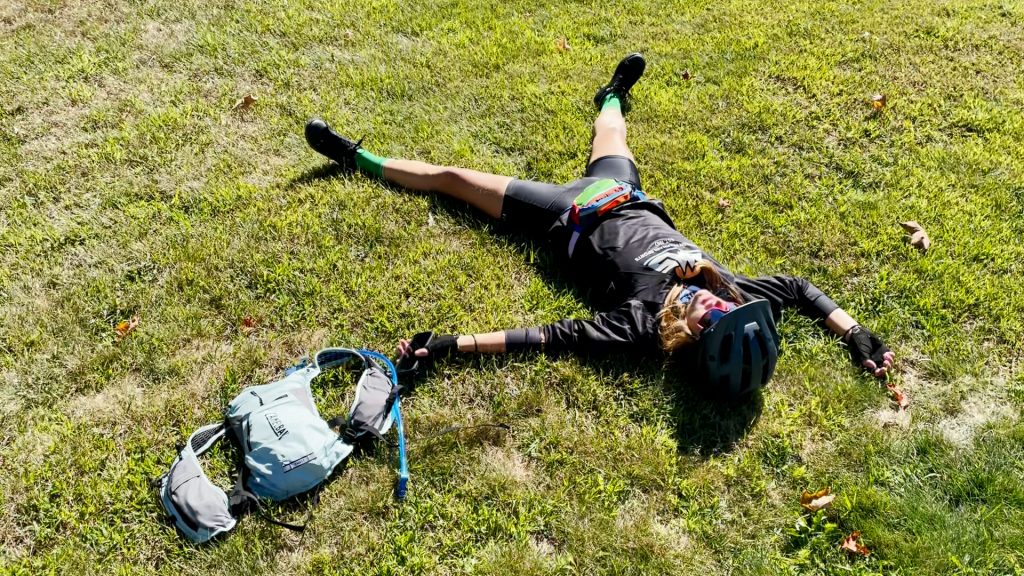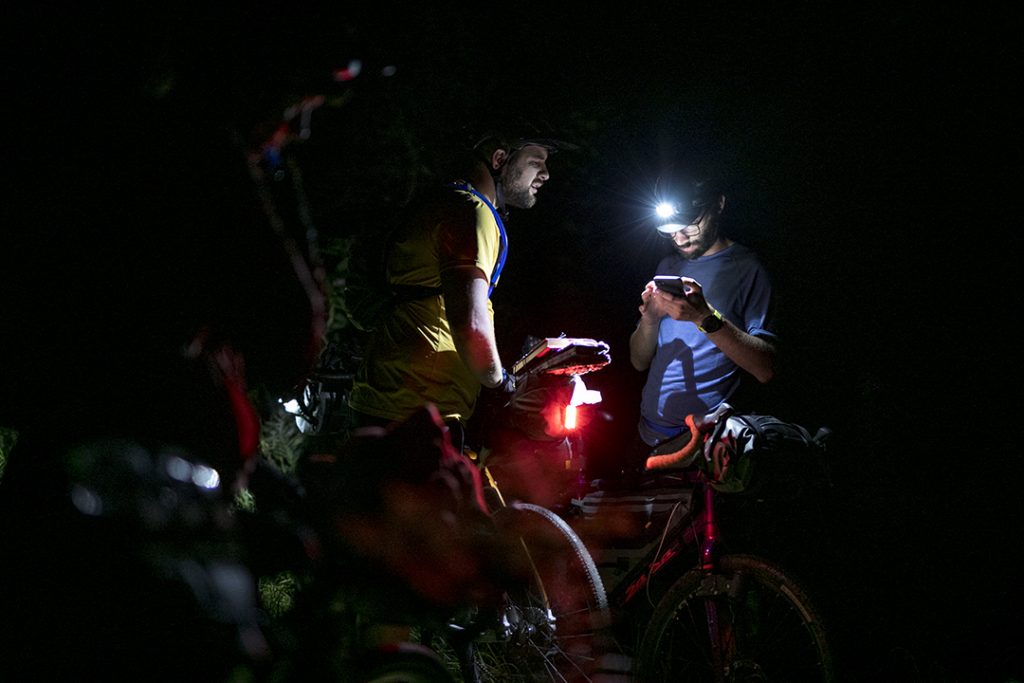Hindsight is always 20/20. Back in May, I pitched to the EMS team that we hike the Long Trail over the summer. I was met with a resounding and rightly-so “no,” and in reconciliation of that fact, decided we should try to do at least something, if not a thru-hike. That’s when I came across an epic Vermont bikepacking route that stopped at over 10 craft breweries and traversed some of the most beautiful backroads of the Green Mountain State—which also seemed kind of hard. Nonetheless, the reception from the team turned from no to maybe and this is how the thru-hike turned into a thru-bike (neither of which I have any experience with).
Four months later, we were testing our mettle in the middle of nowhere with gear loaners from our partner brands and the Bikepacking.com route on our GPS. It was an epic and beautiful 5-day ride, with its fair share of struggles and learning opportunities. Now that the Green Mountain Gravel Growler is complete and we’ve reviewed the route, I’m going to share some of those learning opportunities I had with you so you can benefit from the hard won lessons, too.
1. Train…a little.
Collectively, our team had a night or two of bikepacking experience under our belts so we were all green going into it. That said, each of us arrived to the challenge with different training and areas of strength. I can only really speak for myself here, so I’ll begin by saying I was the least prepared out of the four of us and it showed at the outset. From being the last one up the hills to the last one out of camp, the biggest takeaway I have here is I could have slowed the team down less here if I had practiced more, or as Mike kept reminding me, gotten “time on bike.” I did go on a few practice rides, but in my defense the Black Diamond Haanjo 8c got to me two weeks before takeoff, so my first training ride (if you don’t count the one or two 30-milers I did with my ’96 Specialized), was the 83-mile Cross NH Adventure Trail a week or so before. The best way to describe this route is flat, and the best way to describe the GMGG is not. In fact, I think the only stretch of flat we hit on the entire route was on the second to last day heading to Bristol. But we’ll get to that later.
As daunting as it may seem, developing a training plan of some kind is key, especially if you’re new to multi-day biking. Ryan created a 10-week training plan mixing fast, difficult climbs, warmups, and recovery rides with weekly time goals and lo and behold, he walked his bike exactly zero times, which is a feat in and of itself for that route. When I asked Ryan for tips on creating that plan, he shared: “I found a training plan for a 100-mile race, which would theoretically get us accustomed to longer days, but it wasn’t designed for day-after-day-after-day. So I used some of the same principles (one warm up day, one fast ride, one long ride per week as well as increasing the long rides by not more than 10% week over week) to stretch it out and then lumped the days together so we were riding back to back. It seemed like it worked reasonably well?”

2. Know Thy Route
This goes without saying, but just because you have the route downloaded on your phone doesn’t mean you’re dialed in. We carried a paper map alongside having the route on our RidewithGPS, and changed course as time and circumstances called for it. Ryan was a strong leader in that he navigated seamlessly, made calls on the fly, and was incredibly efficient when time was of the essence (i.e., finding campsites in the dark). To be a strong teammate, you need to support when these situations arise, and this is another area where I fell short. I had a general idea of the route but when it came time to help make decisions, I wasn’t confident in correcting course and was left wishing I could have been of more use as a co-pilot. Even if you’re not the leader of the pack, you should know enough to help out when things get complicated on a trip, so do your due diligence and research the route thoroughly.

3. What vs. How You Pack
When bikepacking, you don’t have much of a choice but to pack efficiently. Similar to backpacking, you have to utilize and maximize every nook and cranny while staying light, except that when bikepacking, you have a lot less space to work with and the packs never seem to want to pack the same way twice. Even though I took only necessities, how I packed became my downfall in the end. It doesn’t help that I’m a procrastinator by nature, but my disorganization ate up time between pit stops and setting up/breaking down camp, so I immediately started taking notes from the team. First, I had some bags to organize, but not enough. Next time I would bring smaller, clear bags to divvy up the bulk and know what is where. I had wires pouring out of my pockets every which way, which was exacerbated by the fact that I was carrying cords for a GoPro, phone, portable charger, USB port, and so on and so forth. Second, I would practice putting them away multiple times like my teammates had suggested. Mike had his pack game dialed in: Not just what he packed, but how. The decisions of what goes into what bag, the order in which things went in, and how they sit in the pack, are all crucial to getting them to fit in each and every time you pack up. I asked Mike to break down his packing process for a week of bikepacking so that you could garner the same wisdom I received that week:
4. Water>Beer
A bikepacking route based on craft breweries is kind of brutal. The idea of it sounds like the ultimate vacation, but I’m just going to say the video clip where I’m struggling up the hill saying “I feel like I’m going to throw up” was not the only one caught on video, and leave it at that. You almost have to train your stomach for this trip, although I’m not sure how to go about that. Have an IPA before one of your strenuous training rides and you’ll see what I mean. The lesson gleaned here? Water before beer. If your teammates are reminding you to drink water on your ride breaks, you’re doing something wrong. By the end of the trip, I was replacing pints with pitchers of water. It is unlikely that your bikepacking trip will include 10 breweries, but regardless, the importance of hydration remains. Know where your fill-up stations are on your route, carry a small plastic/compressible water bottle for quick fill ups, and have quick hits of electrolytes ready.

5. Expect Weather to Weather
The forecast called for four beautiful days of 60- to 70-degree weather and sunny skies with the chance of rain on day five. And rain it did. I was so miserable on the final day of our trip that I almost took the team up on their offer to pick me back up at Fiddlehead Brewing after they finished the last six miles of the route. I had biked well over 200 miles at that point, and the weather paired with my unpreparedness almost did me in, to the point that I didn’t want to ride a mere few miles back to our car. All of this is to say, it was incredibly stupid of me to not pack a rain jacket. I don’t know if it was one of those items I thought I could just “pick up along the way” or what, but I was really riding on the week’s projected forecast, which you should of course never do. I didn’t have a lightweight packable jacket that I was happy with and didn’t buy one in time for the trip, but I should have opted for what I had at home and made room for it in my bags, because the cold rain, on top of being unsafe, almost made me want to call it. Below is our final pit stop where the kind fellows at Fiddlehead Brewing gave me a trash bag, which strangely renewed my spirits.

All in all, many of these takeaways are obvious, but to a new bikepacker (and biker at that), they are worth repeating, over and over. With that said, I would dive in headfirst all over again given the chance (with some of the above changes to better carry my weight). If you’re lucky enough to have a team that is patient, positive, and up for anything, then you’re lucky. Find those people, try something new, and learn a lot from it. My biggest advice to share after this trip?
Go and be really bad at something.
(If you have any tips or lessons learned on your bikepacking travels, we want to hear them below.)
Ellen Estabrook
Ellen is a social media marketer who enjoys weekends spent unplugged in the woods. With backgrounds in psychology and counseling, she has a deep gratitude for the outdoors and its role in mental health and hopes to share that with others.
Related Posts
April 2, 2024
10 Tips for Mountain Biking Etiquette During Mud Season
One rough spring could ruin the…




